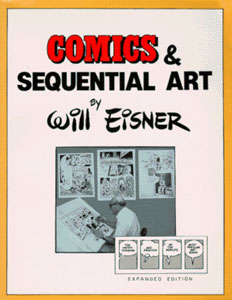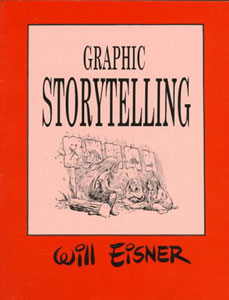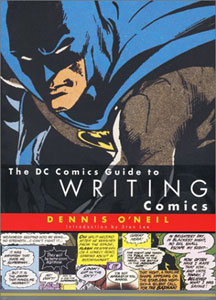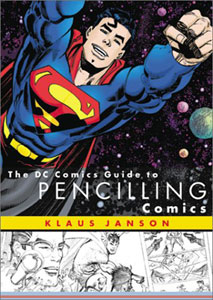|
|
 
|
| . |
|
|
|
|
|
|
| WILL
EISNER |

|
COMICS
&
SEQUENTIAL
ART |
| by Will Eisner |
Paperback: 164 pages
Poorhouse Press
ISBN: 0961472812 |
$19.95

|
| Based on the
popular course Eisner taught for several years at New York's School of
Visual Arts, this lovingly written book on visual storytelling contains
an accumulation of his ideas, theories and advice on the practice of graphic
story-telling and the uses to which the comic book art form can be applied.
Whether you're a film student, literature student, artist or simply a fan
of good storytelling, you'll love this book filled with Eisner's cartoons. |
|
|
|
Legendary comics
creator Will Eisner turns a fine eye toward the principles of graphic storytelling
in this extraordinary work, based on his popular Sequential Art course
at New York's School of Visual Art. Readers will learn the basic anatomy
of sequential art, the fundamentals of crafting stories, and how the medium
works as a means of expression--a literary form that uses the arrangement
of images and words to narrate a story or dramatize an idea. Eisner has
created the most insightful and dynamic examination of the comic art form
to date. It's perfect for use by the serious student, practicing professional
and curious comic fan. The accumulation of ideas, theories and advice culled
from his more than sixty years of experience is stunning to behold.
.
"Eisner has written an important,
possibly definitive guide book to the creative process."
--Publishers
Weekly
.
About the Author
Will Eisner is universally
acknowledged as one of the great masters of comic book art. His famous
weekly newspaper comic book insert, "The Spirit," made him one of the most
influential comic book creators of all time. In 1978, Eisner wrote and
drew the pioneering graphic novel, A Contract with God. For 18 years he
taught classes in Sequential Art at New York's School of Visual Art, and
in that time produced eight more graphic novels. Will Eisner lives in Tamarac,
Florida. |
|
|
|
|
|
|
| WILL
EISNER |

|
GRAPHIC
STORYTELLING |
| by Will Eisner |
Paperback: 164 pages
Poorhouse Press
ISBN: 0961472820 |
$24.95

|
| A companion
to Comics & Sequential Art, this book takes the principles examined
in that title and applies them to the process of graphic storytelling.
Eisner shows comic artists, filmmakers and graphic designers how to craft
stories in a visual medium. They'll also learn why mastering the basics
of storytelling is far more important than the hollow flash and dazzle
seen in lesser work. |
|
|
|
| Readers will
learn everything from the fine points of graphic storytelling to the big
picture of the comics medium, including how to: * Use art that enhances
your story, rather than obscuring it * Wield images like narrative tools
* Write and illustrate effective dialogue * Develop ideas that can be turned
into dynamic stories These lessons and more are illustrated with storytelling
samples from Eisner himself along with other comic book favorites, including
Pulitzer Prize-winner Art Spiegelman, Robert Crumb, Milton Caniff and Al
Capp. |
|
|
|
|
|
|
| The
DC Comics Guide |

|
to
WRITING Comics |
| by Dennis O'Neil |
Paperback: 128 pages
Watson-Guptill Publications
ISBN: 0823010279 |
$19.95

|
| There must be
dozens of books on how to draw comics, but even the best artists need to
tell a good story. Who can teach them? Dennis O'Neil. A comics writer and
editor for more than 20 years, O'Neil oversees DC Comics' Batman titles--one
of the most successful comics franchises ever. In addition, he's a bestselling
novelist, a screenwriter, and a writing teacher. So when it comes to storytelling,
O'Neil knows his stuff. In this guide he delivers his knowledge in a succinct,
no-nonsense style. |
| O'Neil explains
three-act story structure and examines subplots, characterization, and
methods for developing drama and suspense. He then applies these concepts
to comics' specific forms: graphic novels, miniseries, maxiseries, and
the rare megaseries (such as Batman: No Man's Land, a year-long über-narrative
played out across five comics titles). As in good comics, words and images
work together in this book. Every idea is illustrated by panels or pages
from great moments in DC Comics lore. Especially illuminating are the script
excerpts that come paired with the comic book pages they describe.
Strangely, the book ignores
the visual side of comics writing. Modern comics scripts specify shots,
angles, and blocking in movie-director fashion, but that craft is never
addressed. (DC has a good opportunity here for a second volume.) However,
what this book sets out to teach--storytelling--it does quite well. Aspiring
comics writers won't just learn theory, they'll be empowered, because O'Neil
provides a framework for crafting new tales.
--J.B. Peck
.
From Booklist
O'Neil has been scripting
comics professionally for nearly two generations, and he offers much good
sense and valuable information about his craft. Although an ex-Marvelite
endorsed in a foreword by Stan Lee himself, O'Neil's principal experience
has been with DC, for whom he started with Batman and Superman and proceeded
to most of the other titles in the company's catalog. He provides everything
from a basic glossary, complete with visual examples, of scripting concepts
to advice on characterization--something vulgarly and erroneously supposed
not to exist in comics--to guidance on work habits and concludes by discussing
the various kinds of comic books, broadly conceived. He exemplifies from
DC's stable, which may make the book enticing to even the fan who isn't
particularly interested in becoming a scripter. But above all, O'Neil addresses
the universals of writing in a way that makes the book useful to all aspiring
scripters, regardless of their knowledge of comics.
--Roland
Green
Copyright © American
Library Association. All rights reserved.
|
|
|
|
|
|
|
| DC
Comics Guide |
 |
to
PENCILING Comics |
| by Klaus Janson |
Paperback: 128 pages
Watson-Guptill Publications
ISBN: 0823010287 |
$19.95

|
From Booklist
Here's a rich, well- and
appropriately illustrated resource that goes far beyond its title. The
author, an artist and comics editor, writes with clarity and insight about
every aspect of creating comics: techniques for drawing human anatomy,
effects of light and gravity on clothing and scenery, integration of text
and image, and more. There's plenty of information for comics consumers,
too--for example, how comics storytelling (and storytelling in general)
works. |
| Janson doesn't
limit his art or story examples to DC Comics; he uses a variety of sample
pages from a wide range of publications, as well as original sketches,
to clarify discussions. A valuable book for librarians and teachers as
well as art students and comics fans.
Francisca Goldsmith
Copyright © American
Library Association. All rights reserved .
|
|


